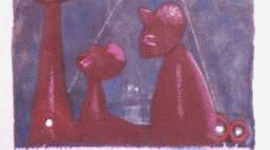Experiential Treatment for PTSD
Interview with Kate Hudgins
Creator of a remarkable model for treating survivors of trauma and author of, "Experiential Treatment for PTSD: The Therapeutic Spiral Model."
Kate Hudgins, Ph.D., TEP, is a clinical psychologist and Board Certified Trainer, Educator, and Practitioner in Psychodrama, Sociometry and Group Psychotherapy. She has worked with trauma survivors for twenty years, developing the Therapeutic Spiral Model for treating trauma with action methods and introducing the model to communities worldwide through international training programs and presentations.
In 2000, Dr Hudgins founded the Therapeutic Spiral International charity in Charlottesville, Virginia, for which she currently acts as Training Director. In 2001 she received the Innovator's Award from the American Society for Group Psychotherapy and Psychodrama (ASGPP) in recognition of her work in developing the Therapeutic Spiral Model.
Dr Hudgins' most recent publication is Experiential Treatment for PTSD: The Therapeutic Spiral Model, published by Springer in 2001, she co-edited Psychodrama with Trauma Survivors: Acting Out Your Pain with Peter Felix Kellermann.
Visit Therapeutic Spiral International to learn much more about the Therapeutic Spiral Model, as well as about Kate, the action teams, and to read fascinating articles about experiential methods of treatment.
Tammie: I want to start by sharing with you Kate how very impressed I am with the Therapeutic Spiral Model. What I witnessed and experienced during the "Restoration and Reconciliation" workshop was truly amazing.
continue story below
Kate: Thank you Tammie. I want to say that the healing was a group effort with the trained team and the people who attended the workshop. The Therapeutic Spiral Model provides safety and people find a place for healing---it is certainly a co-creation.
Tammie: I realize that this is a tall order as TSI is extremely complex, but I'm wondering if you could provide readers with an explanation of what the Therapeutic Spiral Model is.
Kate: First to clarify...TSI is our nonprofit agency, Therapeutic Spiral International, that provides the administrative support and funding for the Therapeutic Spiral Model, a method of treating trauma using experiential methods. TSI is our organization. TSM is the model of healing. The quick answer is that The Therapeutic Spiral Model is a clinical method of change for trauma survivors.
Tammie: When I first heard about TSI, I have to admit that it stirred up some old prejudices I had about psychodrama's potential to overwhelm survivors of trauma. How does TSI differ from classical psychodrama?
Kate: I actually fully agree that classical psychodrama and other experiential methods like Gestalt therapy can overwhelm survivors of trauma. Action methods are powerful and can access dissociated feelings, child states, and trauma memories. That is the good news. It is also the bad news. TSM was created to prevent trauma survivors from being overwhelmed by their feelings or memories from the past when using experiential methods. TSM is a clinically driven method of intervention that emphasizes containment and safety. TSM modifies classical psychodrama to prevent uncontrolled regression, emotional outbursts, and retraumatization.
Tammie: What would you say that TSI offers that more traditional methods of treatment for trauma survivors does not?
Kate: Traditional methods of treatment for trauma survivors focus on symptom control and reduction through medication and talk therapy. TSM offers full developmental repair and healing from past traumas.
Tammie: What are trauma bubbles?
TSM is a survivor based model of healing. I have tried to take complex psychological concepts and words and bring them into everyday language that the survivor can use to communicate with therapist, friends, and family. Trauma bubbles are a graphic description of the experience of the aftermath of trauma that survivors immediately understand.
Trauma bubbles contain fragmented thoughts, feelings, images, and urges that are not fully conscious. They "hang around" in the space around a survivor and can pop unexpectedly. When these trauma bubbles pop, unprocessed trauma material and feelings flood present awareness and the survivor is thrown into the past.
TSM teaches you how to consciously access the memories in these trauma bubbles so that they can be safely experienced and expressed. Only then will the past stop popping into the present and disrupting survivors' lives.
Tammie: Has there been any research conducted on TSI and if so, what were the results?
Kate: We have found an 82% success rate following a weekend workshop using the Therapeutic SPiral Model. Clients and their therapists report decreases in out of control thoughts, feelings, and behaviors and an increase in strengths.
In 2001, a single case study showed a significant decrease in dissociation and general trauma symptoms for a woman with body memories who was stuck in her individual weekly talk therapy. (Hudgins, Drucker and Metcalf, 2001).
You can view this reference and additional research support for experiential methods with trauma at our website www.therapeuticspiral.org
Tammie: What kind of training is required of the members of your action trauma teams?
Kate: That varies on what role you take on the team. To build a local TSM team takes about three years to train a team leader to use the Therapeutic SPiral Model to treat PTSD. TSI has a three year post-graduate accreditation program that builds teams and provides quarterly training to professionals.
However, many survivors train to be a trained auxilary ego on a team so they can give back to others. If a survivor doesn't have clinical or psychodrama training, it can take about a year to learn enough trauma theory and to get enough practice on a team to be a qualified team member.
Tammie: Your work is incredibly intense and demanding, is there any kind of system in place to prevent team members from suffering from secondary posttraumatic stress disorder?
Kate: This has always been a major consideration with our Action Trauma Teams. As you may have noticed, we had team meetings in the morning, at lunch and in the evening while we were doing the Healing SPiritual Trauma workshop.
During those meetings, team members shared their own responses, feelings, and re-activations of trauma material. They identified and worked through any trauma patterns that started to show up. Together, we processed, we cried, we talked, and we hugged. We stayed clear so we could provide a safe container for the participants. kind of like the good enough parent.
Tammie: I understand that you've been using this model with trauma survivors all over the world, and that you established Therapeutic Spiral International in 2000. What is the mission of this organization?
continue story below
Kate: TSI's mission is to provide education, training, and direct services to trauma survivors in the global community using the Therapeutic Spiral Model.
Currently, we have ongoing training groups in Ottawa, Canada, Charlottesville, Virginia, Boulder, Colorado, and London, England. We are building teams in the community in Johannesburg, South Africa and Belfast and Derry, Northern Ireland. You can view our website at therapeuticspiral.org for our schedule.
Tammie: "I'm reading your book, "Experiential Treatment for PTSD: The Therapeutic Spiral Model" and I'm finding it extraordinarily helpful. I'm struck by how you've managed to write about very complicated issues in such clear and understandable language. I want to let you know how much I'm appreciating that!
Kate: Thank you Tammie. It took ten years and three total rewrites to make the book user friendly. I want it to show people how experiential methods like the Therapeutic Spiral Model can truly make a difference in the lives of trauma survivors. As a woman with my own history of trauma, I believe people can recover fully from PTSD, not just learn to manage the symptoms.
Tammie: After having both witnessed and experienced the opportunity for healing that TSM offers, I'm convinced that this work most definitely makes a difference in the lives of those trauma survivors who have been fortunate enough to have participated in this process. I want to thank you Kate for making this opportunity for healing possible, and for taking the time to do this interview with me.
Kate: Thanks for giving me this opportunity to tell people about this hopeful method.
next:On Humor and Healing: An interview with Jo Lee Dibert-Fitko
APA Reference
Staff, H.
(2008, December 6). Experiential Treatment for PTSD, HealthyPlace. Retrieved
on 2025, December 27 from https://www.healthyplace.com/alternative-mental-health/sageplace/experiential-treatment-for-ptsd

